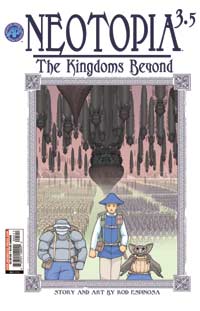Neotopia,
Volume 3
story and art by Rod Espinosa
In
Volume 3 of Rod Espinosa's epic Neotopia, the journey
of Nalyn and the Mathenian army continues, exploring the continents
and discovering new lands and potential allies. These discoveries
are a little more schematized and artificial than the ones
in Volume 2, but also in some ways more thought-provoking.
The
first is Shielliniath, the last refuge of a race of elves.
If elves seem a little trite compared to the book's other
inhuman races (humanoid bats, cybernetic telepathic dolphins,
and a wingless anthropomorphic pterodactyl), think of them
as Neotopia's aborigines, most reminiscent of Native American
tribes. The elves isolate themselves, hunt with low technology
and high sophistication, and harbor deep grudges against
and distrust for humans. Espinosa continues to explicate
the difficulty of winning loyalty and unity against the
backdrop of history, a problem at least as prevalent on
our present Earth.
The
next few issues concern themselves with the kingdom of Elyssion,
split catastrophically into male and female factions. Here
Espinosa's names are almost too transparent; "Maledon"
suggests both "male domination" and "malice,"
while "Lesazon" patently breaks down into "lesbian"
and "amazon."
The
Maledonians are sketchily drawn. Almost pathologically hostile
and distrustful, they don't stick around long enough for
us to learn much about how they function as a society. They
seem to have received religion and regimental military in
the cultural divorce, as well as a caste system.
Espinosa
mostly uses the Maledonians to define the Lesazonians by
difference. The matriarchal half is portrayed with motifs
we're all familiar with by now: the vaguely Greco-Roman
costumes and architecture, the proscriptions against violence
combined with almost godlike ability to deliver the same.
All we need are bullet-deflecting bracelets and a truth-eliciting
lasso and we're on Paradise Island. Fortunately, Espinosa
doesn't try to push the similarities harder than this; instead
he gives a pretty convincing origin story for the gender-based
splintering, and a deadly, dirty secret that could save
or condemn Neotopia utterly.
 |
Throughout
the volume Espinosa continues to deploy the strengths that
have kept the series an engaging read for the eyes as well
as the brain. His palette is exquisitely chosen, depicting
bright naturally-lit scenes and gloomy, real darkness with
a faithfulness more suggestive of fine painting than comic
art. Complex scenes are filled with detail, important revelations
about secondary characters hide in corners of full-page
scenes, and we stop frequently to drink in the grandeur
of a world with the clock turned back to a time of natural
beauty. We rarely see Espinosa's charismatic heroes without
a host of others beside or behind them, such that it's difficult
to forget that true heroism doesn't result from the actions
of the few and glorified but from the many and unified.
These are themes to which many an epic fantasy pays lip
service, but in Neotopia they saturate the art
itself.
The
story, too, gives the impression of being larger than the
pages it's given. Though the pages of silent visuals alternate
with passages of wordy dialogue, there's so much to tell
that the diary entries and textbook histories rendered in
prose at the end of each issue are more required reading
than flavor text. Nagging questions are answered (or at
least acknowledged) there, background on how single-sex
societies function is provided, and technology is explained
and explored. It's hard to imagine how these details could
have been incorporated into the main story, and their presence
helps the impression of a three-dimensional world.
Along
with the large-scale struggle, the small-scale struggles
continue. Nalyn and Philios experience more moments of affection
that test their professional relationship. Marro the elf
finds himself torn between loyalty to his Duchess and desire
to live among his own people. And the slave insect Philios
rescued during Volume 2 here learns to live as a natural
creature, perhaps providing a solution to the overwhelming
number of Krossian forces.
If there's
any criticism to offer of Neotopia, "overwhelming"
might be the word. There's so much detail to Espinosa's
world, so many factors accumulated along the journey that
it can be difficult to keep them straight. Best to trust
that their creator will do so, sailing confidently into
the battle ignited in Volume 4.
Rating:

|







